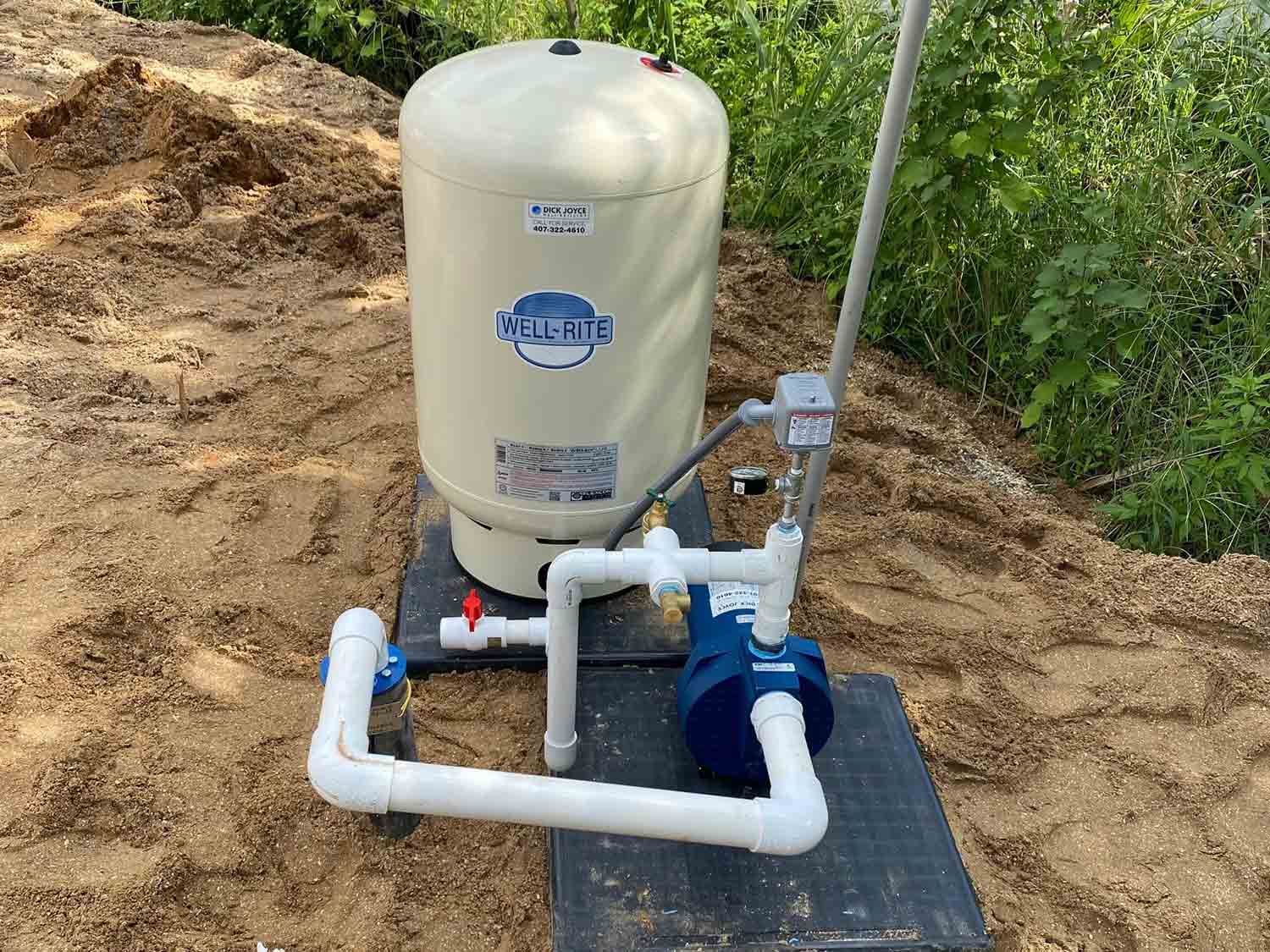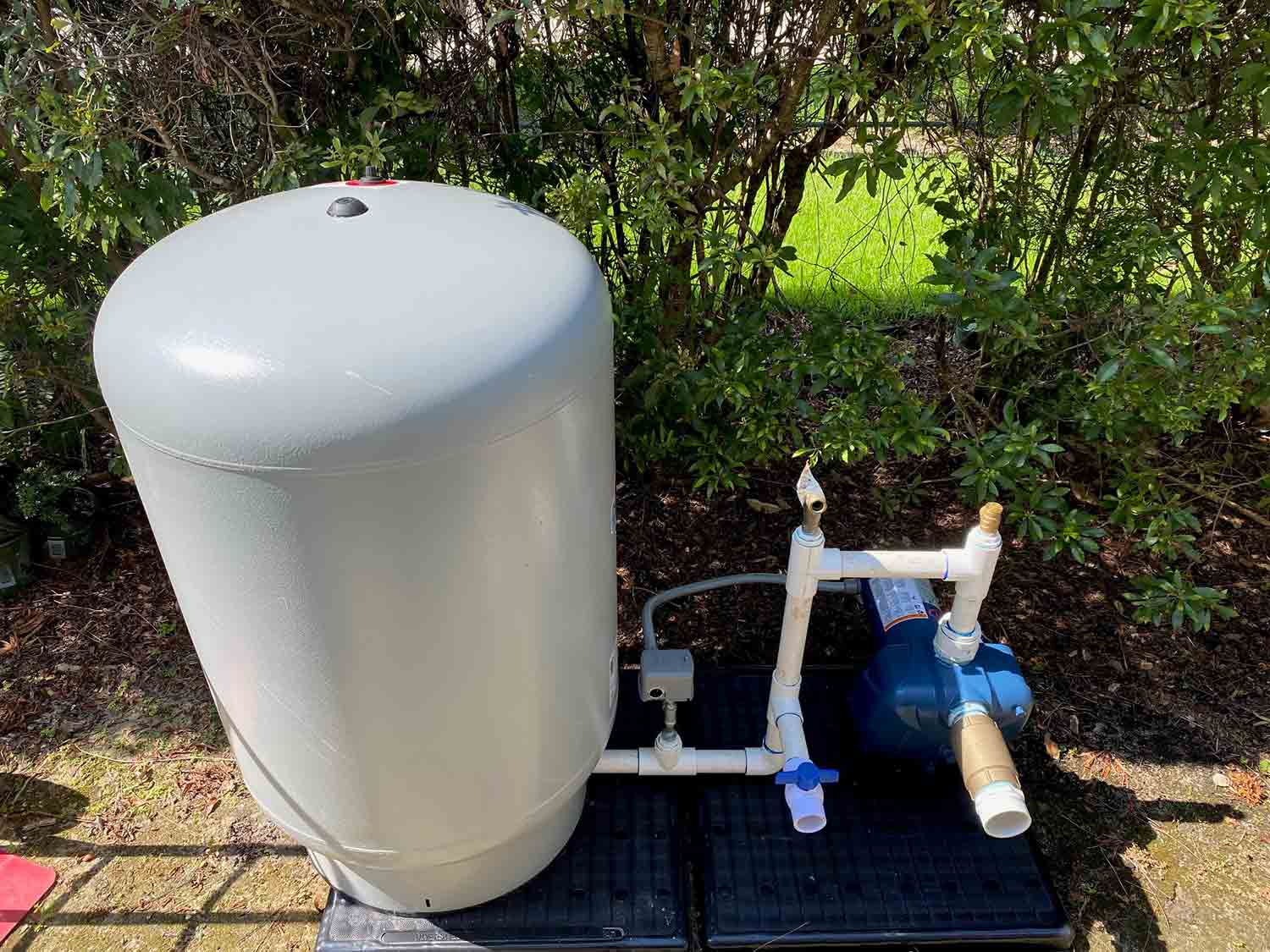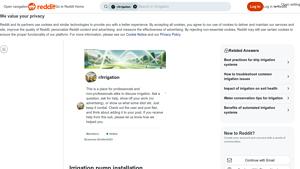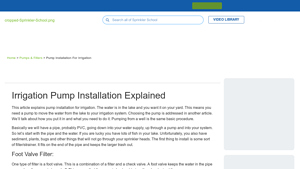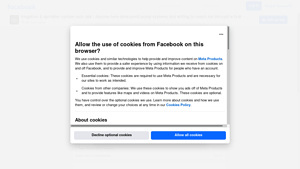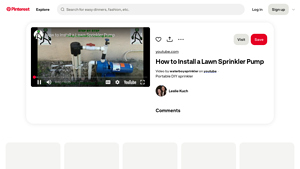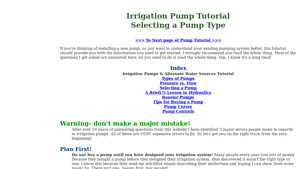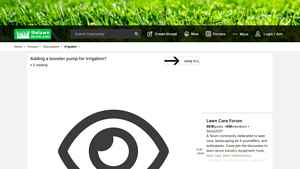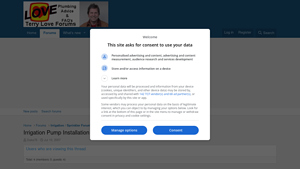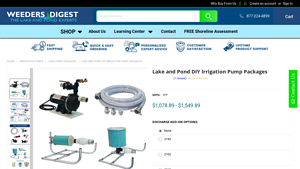Introduction: Navigating the Global Market for installing irrigation pump
Navigating the global market for installing irrigation pumps presents a unique set of challenges, particularly for B2B buyers in regions such as Africa, South America, the Middle East, and Europe. A key concern is sourcing the right irrigation pump system that not only meets operational demands but also aligns with budget constraints and local environmental conditions. This comprehensive guide serves as a valuable resource, detailing various types of irrigation pumps, their specific applications, and essential factors for supplier vetting.
By addressing critical elements such as cost analysis, installation best practices, and maintenance strategies, this guide empowers international buyers to make informed purchasing decisions. Understanding the intricacies of irrigation pump systems is vital for optimizing agricultural productivity and ensuring sustainable water management.
Moreover, buyers will gain insights into common pitfalls associated with pump selection and installation, equipping them with the knowledge needed to avoid costly mistakes. With a focus on actionable strategies and expert recommendations, this guide aims to enhance the efficiency and effectiveness of irrigation systems worldwide, ultimately supporting the growth and sustainability of agricultural enterprises across diverse markets.
Understanding installing irrigation pump Types and Variations
| Type Name | Key Distinguishing Features | Primary B2B Applications | Brief Pros & Cons for Buyers |
|---|---|---|---|
| Centrifugal Pumps | Uses rotational energy to move water; efficient for high flow rates | Large agricultural fields, commercial landscaping | Pros: High efficiency, low maintenance. Cons: Not ideal for high-pressure applications. |
| Submersible Pumps | Designed to be submerged in water; suitable for deep water sources | Irrigation in areas with deep wells or lakes | Pros: Can handle high volumes, quiet operation. Cons: More complex installation and maintenance. |
| Booster Pumps | Increases water pressure in existing systems; essential for high elevation areas | Urban landscaping, golf courses | Pros: Enhances system efficiency, versatile. Cons: Can be costly; requires careful sizing. |
| Diaphragm Pumps | Operates with a flexible diaphragm; ideal for precise water delivery | Fertilizer injection, drip irrigation | Pros: Excellent for low flow rates, precise control. Cons: Limited to smaller applications; higher maintenance. |
| Solar-Powered Pumps | Utilizes solar energy; eco-friendly option for remote areas | Sustainable agriculture, remote irrigation | Pros: Low operating costs, environmentally friendly. Cons: High initial investment; dependent on sunlight availability. |
What Are the Characteristics of Centrifugal Pumps and Their B2B Suitability?
Centrifugal pumps are widely recognized for their ability to efficiently move large volumes of water, making them suitable for applications in large agricultural fields and commercial landscaping. Their design allows for high flow rates, which is critical for extensive irrigation systems. When considering a centrifugal pump, B2B buyers should evaluate the pump’s efficiency ratings and compatibility with their existing systems to avoid inefficiencies.
How Do Submersible Pumps Function and Where Are They Best Applied?
Submersible pumps are engineered to operate while fully submerged in water, making them ideal for irrigation applications that require drawing water from deep wells or lakes. Their ability to handle significant water volumes quietly makes them a preferred choice in residential and commercial settings. Buyers should consider the depth of the water source and the pump’s capacity to ensure it meets their irrigation needs effectively.
Why Are Booster Pumps Essential for Certain Irrigation Systems?
Booster pumps play a crucial role in increasing water pressure, particularly in areas with high elevation or where existing water pressure is insufficient. They are commonly utilized in urban landscaping and golf courses, where maintaining optimal irrigation pressure is vital. When purchasing a booster pump, B2B buyers need to assess their system’s pressure requirements and ensure proper sizing to maximize performance.
What Advantages Do Diaphragm Pumps Offer for Precision Irrigation?
Diaphragm pumps are distinguished by their operation through a flexible diaphragm, allowing for precise control of water delivery. This makes them particularly effective for applications like fertilizer injection and drip irrigation systems. B2B buyers should consider their specific flow rate needs and the potential for maintenance, as diaphragm pumps may require more frequent servicing compared to other types.
How Do Solar-Powered Pumps Contribute to Sustainable Irrigation Solutions?
Solar-powered pumps harness solar energy, providing an eco-friendly alternative for irrigation in remote areas where traditional power sources may not be available. They are particularly beneficial in sustainable agriculture initiatives. Buyers should weigh the initial investment against long-term savings on operational costs, as well as the pump’s efficiency in relation to local sunlight availability.
Key Industrial Applications of installing irrigation pump
| Industry/Sector | Specific Application of Installing Irrigation Pump | Value/Benefit for the Business | Key Sourcing Considerations for this Application |
|---|---|---|---|
| Agriculture | Crop irrigation in large-scale farms | Increases yield and optimizes water usage, enhancing profitability | Need for pumps with high efficiency and durability for continuous operation |
| Horticulture | Greenhouse irrigation systems | Maintains optimal moisture levels, promoting plant health and growth | Sourcing pumps with precise control features for varying water needs |
| Landscaping | Residential and commercial landscape irrigation | Enhances aesthetic value and reduces labor costs for maintenance | Consideration for pump size and type based on landscape layout and water source |
| Mining | Dust suppression and site reclamation | Improves safety and compliance while enhancing site recovery efforts | Pumps must be robust and capable of handling specific site conditions |
| Water Management | Municipal water supply systems | Ensures consistent water delivery for urban areas, supporting public health | Compliance with local regulations and standards for water quality and pressure |
How is ‘Installing Irrigation Pump’ Used in Agriculture?
In the agriculture sector, installing irrigation pumps is crucial for efficient crop irrigation, particularly in regions prone to water scarcity. These pumps enable farmers to draw water from rivers, lakes, or underground sources, ensuring that crops receive adequate moisture. The primary challenge addressed by these systems is the inconsistency of rainfall, which can lead to reduced yields. Buyers in this sector should prioritize high-efficiency pumps that can operate continuously under varying conditions, ensuring durability and reliability throughout the growing season.
What Role Does Irrigation Pump Installation Play in Horticulture?
In horticulture, irrigation pumps are essential for managing water in greenhouse environments. These systems help maintain optimal humidity and moisture levels, which are vital for the health and growth of delicate plants. The specific requirements for buyers include pumps that offer precise control over water flow, as different plants may have varying needs. International buyers should consider sourcing pumps that are adaptable to local climates and can efficiently handle the specific water quality parameters of their regions.
How is Irrigation Pump Installation Beneficial for Landscaping?
For landscaping applications, installing irrigation pumps facilitates the efficient watering of both residential and commercial properties. This technology not only enhances the aesthetic appeal of landscapes but also minimizes labor costs associated with manual watering. Buyers must evaluate the size and type of pumps based on the layout and scale of the landscape to ensure effective water distribution. Furthermore, sourcing pumps that can integrate with automated systems can significantly improve water management practices.
In What Ways Do Mining Operations Utilize Irrigation Pumps?
In the mining sector, irrigation pumps are utilized for dust suppression and site reclamation efforts. By controlling dust, these pumps help maintain safety standards and ensure compliance with environmental regulations. The specific requirements for sourcing pumps in this industry include robustness and the ability to handle challenging site conditions, such as varying terrain and water availability. Buyers should also consider the pump’s capacity to deliver water under pressure, which is crucial for effective dust control.
Why is Water Management Critical for Municipal Applications?
Municipal water supply systems rely heavily on the installation of irrigation pumps to ensure a consistent and reliable water supply for urban populations. These systems are essential for maintaining public health and supporting infrastructure. When sourcing pumps for municipal applications, buyers must ensure compliance with local regulations regarding water quality and pressure. Additionally, the durability and efficiency of the pumps are critical, as they must operate reliably over extended periods and under fluctuating demand conditions.
3 Common User Pain Points for ‘installing irrigation pump’ & Their Solutions
Scenario 1: Misalignment Between Pump Size and System Requirements
The Problem: One common challenge faced by B2B buyers is selecting an irrigation pump that is not appropriately sized for their system requirements. This misalignment can lead to insufficient water pressure, inadequate coverage, or operational inefficiencies. For instance, a company may invest in a pump that is marketed for high flow rates but fails to meet the pressure needs of their irrigation system. This can result in wasted resources and increased operational costs as they may need to replace the pump or install boosters to compensate for the mismatch.
The Solution: To avoid this pitfall, buyers should engage in comprehensive system design before purchasing any pump. This involves calculating the total dynamic head (TDH) required for their irrigation system, which includes factors like elevation changes, friction losses, and required flow rates. Consulting with irrigation specialists or using online calculators can provide insights into the exact specifications needed. Furthermore, buyers should scrutinize pump labels carefully, ensuring they understand the performance metrics and limitations. It’s advisable to opt for pumps specifically designed for irrigation applications, as these are more likely to meet the demands of larger systems effectively.
Scenario 2: Poor Site Preparation Leading to Installation Issues
The Problem: Many B2B buyers overlook the importance of site preparation when installing irrigation pumps, which can lead to significant challenges during and after the installation process. A poorly prepared site may result in unstable pump placement, leading to vibrations, misalignment, or even pump failure. For instance, if the ground is not level or if there are obstructions near the pump, it could impact both the installation and the long-term performance of the irrigation system.
The Solution: To mitigate these issues, it is critical for buyers to invest time in thorough site assessment and preparation before installation. This includes clearing the area of debris, ensuring a stable base for the pump, and confirming that the chosen location is above potential flood levels. Additionally, marking out the layout for pipes and sprinkler heads in advance can help visualize the installation process and identify any potential obstacles. For buyers operating in diverse terrains, it may be beneficial to consult local engineers or irrigation experts to tailor the installation process to specific environmental conditions.
Scenario 3: Inadequate Maintenance Knowledge Leading to Downtime
The Problem: After the installation of irrigation pumps, many B2B buyers face challenges related to ongoing maintenance and troubleshooting. Without a clear understanding of the maintenance requirements, pumps can experience breakdowns, resulting in costly downtime and potential crop damage. Buyers may not be aware of how to properly clean filters, check for leaks, or inspect electrical components, leading to a reactive rather than proactive approach to maintenance.
The Solution: To ensure long-term efficiency and reliability of irrigation pumps, buyers should establish a comprehensive maintenance schedule that includes regular inspections and cleanings. They should familiarize themselves with the pump’s operation manual to understand the key components that require attention, such as filters and seals. Additionally, investing in training sessions for operational staff on basic troubleshooting techniques can empower them to handle minor issues before they escalate. Utilizing digital monitoring tools can also provide real-time data on pump performance, helping buyers identify potential problems early on. By prioritizing maintenance education and proactive management, companies can significantly reduce downtime and extend the lifespan of their irrigation systems.
Strategic Material Selection Guide for installing irrigation pump
When selecting materials for installing irrigation pumps, it’s essential to consider various factors that can influence performance, durability, and overall system efficiency. Below is an analysis of four common materials used in irrigation pump installations, focusing on their properties, advantages, disadvantages, and specific considerations for international buyers.
What Are the Key Properties of PVC in Irrigation Pump Installations?
Polyvinyl Chloride (PVC) is widely used in irrigation systems due to its favorable properties. PVC pipes have a high resistance to corrosion and can handle moderate pressure ratings, typically ranging from 150 to 300 psi. This material is also lightweight and easy to work with, making installation straightforward.
Pros: PVC is cost-effective and resistant to many chemicals, which is beneficial for various water sources. Its smooth interior surface reduces friction losses, enhancing flow efficiency.
Cons: However, PVC is less durable under extreme temperatures, becoming brittle in cold conditions and deforming under high heat. Additionally, it may not be suitable for high-pressure applications without reinforcement.
Impact on Application: PVC is compatible with most irrigation media, including freshwater and some treated wastewater. However, it is not recommended for applications involving hot water or aggressive chemicals.
Considerations for International Buyers: Compliance with local standards such as ASTM in the U.S. or DIN in Germany is critical. Buyers in regions like Africa and the Middle East should ensure that the chosen PVC meets local climate conditions and water quality requirements.
How Does Stainless Steel Perform in Irrigation Pump Systems?
Stainless steel is renowned for its strength and corrosion resistance, making it an excellent choice for irrigation pump components, particularly in harsh environments. It can withstand high pressures, often exceeding 500 psi, and is capable of operating in a wide temperature range.
Pros: Its durability ensures a long lifespan, reducing maintenance costs. Stainless steel is also resistant to rust and chemical degradation, making it suitable for various water sources.
Cons: The primary drawback is its higher cost compared to other materials like PVC or aluminum. Additionally, stainless steel can be more challenging to work with due to its weight and the need for specialized tools for cutting and joining.
Impact on Application: Stainless steel is ideal for applications involving saline or chemically aggressive water. It is often used in pump casings and fittings where strength and reliability are paramount.
Considerations for International Buyers: Buyers should verify compliance with international standards like JIS for Japan and EN for Europe. In regions with high humidity or saline conditions, stainless steel is often preferred despite the initial investment.
What Role Does HDPE Play in Irrigation Pump Installations?
High-Density Polyethylene (HDPE) is another popular choice for irrigation systems, particularly for underground piping. HDPE pipes are flexible, resistant to corrosion, and can handle pressures up to 160 psi.
Pros: The flexibility of HDPE allows for easy installation in various terrains, and its resistance to UV light ensures longevity when exposed to sunlight. Additionally, HDPE is less likely to crack under stress compared to PVC.
Cons: While HDPE is durable, it can be more expensive than PVC. Furthermore, it may require specialized fittings and welding techniques for installation, increasing complexity.
Impact on Application: HDPE is suitable for transporting potable water and can handle a range of irrigation media. Its resistance to chemicals makes it versatile for different applications.
Considerations for International Buyers: Buyers should ensure that HDPE products comply with local regulations and standards, such as ASTM and ISO. In regions like South America and Africa, where soil conditions may vary, HDPE’s adaptability can be a significant advantage.
How Do Cast Iron Components Enhance Irrigation Pump Systems?
Cast iron is traditionally used for pump housings and other heavy-duty components due to its strength and durability. It can withstand high pressures and is resistant to wear and tear.
Pros: Cast iron is incredibly robust and can handle extreme conditions, making it suitable for high-capacity irrigation systems. Its longevity reduces the need for frequent replacements.
Cons: However, cast iron is heavy and can be challenging to install. Additionally, it is prone to rust if not properly coated or maintained, which can lead to performance issues over time.
Impact on Application: Cast iron is ideal for high-pressure applications and can handle a variety of water types, including those with high sediment content.
Considerations for International Buyers: Compliance with standards such as ASTM and DIN is crucial. Buyers should also consider the local climate, as regions with high humidity may require additional protective coatings to prevent rust.
Summary Table of Material Selection for Irrigation Pumps
| Material | Typical Use Case for installing irrigation pump | Key Advantage | Key Disadvantage/Limitation | Relative Cost (Low/Med/High) |
|---|---|---|---|---|
| PVC | Above-ground irrigation piping | Cost-effective and corrosion-resistant | Brittle in extreme temperatures | Low |
| Stainless Steel | Pump casings and fittings | High strength and durability | Higher cost and installation complexity | High |
| HDPE | Underground piping for irrigation | Flexible and UV resistant | More expensive and requires special fittings | Medium |
| Cast Iron | Heavy-duty pump components | Extremely robust for high-capacity systems | Heavy and prone to rust without maintenance | Medium |
This strategic material selection guide provides essential insights for B2B buyers in the irrigation industry, facilitating informed decisions that align with specific regional requirements and application needs.
In-depth Look: Manufacturing Processes and Quality Assurance for installing irrigation pump
What Are the Key Stages in the Manufacturing Process of Irrigation Pumps?
The manufacturing process of irrigation pumps is a multi-stage procedure that ensures high-quality products capable of performing under various conditions. Understanding these stages is crucial for B2B buyers, as it provides insights into the reliability and performance of the pumps they are considering.
Material Preparation: What Materials Are Used in Irrigation Pump Manufacturing?
The first stage involves selecting and preparing the raw materials. Common materials include high-grade stainless steel, cast iron, and various plastics. Stainless steel is often chosen for its corrosion resistance, especially in environments exposed to water and soil. Cast iron provides durability and strength, while plastics can be used for components like impellers and housings due to their lightweight and resistance to chemical degradation.
During this phase, materials undergo rigorous quality checks to ensure they meet specified standards. This may involve testing for tensile strength, hardness, and resistance to corrosion. Proper material selection is vital to ensure the longevity and efficiency of the irrigation pumps.
Forming: How Are Components Shaped and Molded?
The forming stage includes various techniques such as casting, machining, and molding.
Casting: This method is commonly used for creating pump housings and impellers. The molten metal is poured into molds, allowing for complex shapes and designs that enhance efficiency.
Machining: Precision machining is employed to create components like shafts and seals. This process ensures that parts fit together accurately, minimizing the risk of leaks and operational failures.
Molding: For plastic components, injection molding is utilized. This technique allows for the mass production of intricate parts with consistent quality.
These processes must adhere to strict tolerances to ensure that the final assembly operates smoothly and efficiently.
Assembly: What Steps Are Involved in Putting Together Irrigation Pumps?
In the assembly stage, various components are brought together to form the complete irrigation pump. This process typically involves:
Sub-assembly of Major Components: Parts such as the motor, impeller, and housing are assembled separately before being combined into the final product.
Integration of Electrical Components: For electrically powered pumps, wiring and control systems are integrated at this stage. Ensuring proper electrical connections is critical for safety and functionality.
Final Assembly: All sub-assemblies are combined, and the pump is sealed and tested for leaks.
Quality Checks: At this stage, initial quality control checks (IQC) are conducted to catch any issues before the pump moves to the finishing stage.
This meticulous assembly process is crucial in ensuring that every pump operates efficiently under various conditions.
Finishing: How Are Irrigation Pumps Prepared for Market?
The finishing stage involves applying protective coatings, painting, and final inspections. Coatings may include anti-corrosive paints or finishes that enhance durability, particularly for pumps used in harsh environments.
Additionally, this stage includes rigorous quality assurance checks, such as functional testing, to ensure that the pump meets performance standards. Pumps may be subjected to pressure tests to confirm they can withstand operational conditions without failure.
What Quality Assurance Standards Are Relevant for Irrigation Pumps?
Quality assurance is a critical aspect of the manufacturing process for irrigation pumps. Adherence to international standards ensures that products are reliable and safe for end-users.
Which International Standards Should B2B Buyers Be Aware Of?
ISO 9001: This standard focuses on quality management systems. Manufacturers certified under ISO 9001 have demonstrated their ability to consistently provide products that meet customer and regulatory requirements.
CE Marking: In Europe, CE marking indicates conformity with health, safety, and environmental protection standards. For irrigation pumps, this marking assures buyers that the product meets EU requirements.
API Standards: The American Petroleum Institute (API) provides standards related to pumps used in oil and gas applications. While not directly applicable to agricultural irrigation, manufacturers adhering to these standards often demonstrate high-quality manufacturing processes.
What Are the Quality Control Checkpoints in the Manufacturing Process?
Quality control in irrigation pump manufacturing typically includes several key checkpoints:
Incoming Quality Control (IQC): Raw materials are inspected upon arrival to ensure they meet specifications.
In-Process Quality Control (IPQC): During manufacturing, various stages are monitored to ensure compliance with quality standards. This may involve measuring tolerances and conducting interim tests.
Final Quality Control (FQC): Before packaging, pumps undergo comprehensive testing, including performance and durability assessments. This ensures that every unit meets or exceeds industry standards.
How Can B2B Buyers Verify Supplier Quality Control?
For international B2B buyers, verifying a supplier’s quality control processes is essential to ensure they are investing in reliable products. Here are some actionable steps:
Supplier Audits: Conducting audits of potential suppliers can provide insights into their manufacturing processes and quality assurance measures. This can include site visits and review of their quality management systems.
Requesting Quality Reports: Buyers should ask for documentation that outlines the supplier’s quality control procedures, including test results and certifications.
Third-Party Inspections: Engaging third-party inspection agencies can provide an unbiased assessment of a supplier’s quality control measures, ensuring compliance with international standards.
What Nuances Should International B2B Buyers Consider?
When purchasing irrigation pumps from international suppliers, particularly in regions like Africa, South America, the Middle East, and Europe, buyers should consider the following:
Regulatory Compliance: Ensure that the pumps meet local regulations and standards. This may differ significantly from one region to another.
Supply Chain Reliability: Assess the supplier’s ability to deliver consistently, considering potential disruptions in logistics or material availability.
Cultural and Communication Barriers: Be aware of potential language and cultural differences that could affect negotiations and operational processes.
Local Support and Service: Consider suppliers who offer local support for installation and maintenance, as this can significantly impact the long-term performance of the irrigation systems.
By understanding the manufacturing processes and quality assurance measures, B2B buyers can make informed decisions when selecting irrigation pumps, ensuring they choose reliable products that meet their operational needs.
Practical Sourcing Guide: A Step-by-Step Checklist for ‘installing irrigation pump’
To assist B2B buyers in successfully procuring and installing irrigation pumps, this guide provides a clear, actionable checklist. By following these steps, buyers can ensure they are making informed decisions that will lead to efficient and effective irrigation solutions.
Step 1: Define Your Technical Specifications
Understanding the specific requirements of your irrigation system is essential before making any purchases. Determine the size of the area to be irrigated, the type of crops or plants, and the water source available. This will guide you in selecting the right pump type, capacity, and features necessary for optimal performance.
Step 2: Research and Select Pump Types
Different types of pumps serve various irrigation needs. Familiarize yourself with options such as centrifugal, submersible, and booster pumps. Each type has its advantages; for instance, centrifugal pumps are effective for high-flow applications, while submersible pumps are ideal for deep water sources. Ensure the pump you choose matches your operational requirements.
Step 3: Evaluate Potential Suppliers
Before committing to a supplier, thorough vetting is crucial. Request detailed company profiles, case studies, and references from previous clients in similar industries. Additionally, check for certifications and compliance with international standards, especially if you are sourcing from different regions. A reliable supplier will have a proven track record and positive feedback from their clients.
Step 4: Assess Warranty and Support Services
Review the warranty terms and after-sales support offered by the supplier. A robust warranty can protect your investment in case of defects or failures. Additionally, reliable customer support is vital for troubleshooting and maintenance needs. Inquire about the availability of spare parts and the supplier’s response time for service requests.
Step 5: Plan for Installation Logistics
Consider the logistics involved in transporting and installing the irrigation pump. Ensure that the site is adequately prepared, including the necessary tools and workforce for installation. Discuss with your supplier about any installation services they might offer or recommend local experts who can assist in setting up the system efficiently.
Step 6: Conduct Pre-Installation Testing
Before finalizing the installation, perform necessary tests to ensure that the pump and system components function correctly. This may include checking electrical connections, testing for leaks in pipes, and ensuring the filtration system is operational. Address any issues at this stage to avoid complications once the system is in use.
Step 7: Implement a Maintenance Schedule
After installation, establish a regular maintenance schedule to ensure the irrigation pump operates efficiently over time. Regular checks on the pump, filters, and control systems can prevent costly repairs and extend the lifespan of the equipment. Document maintenance activities and any issues encountered for future reference.
By following this checklist, B2B buyers can make informed decisions when procuring and installing irrigation pumps, ensuring long-term efficiency and reliability in their irrigation systems.
Comprehensive Cost and Pricing Analysis for installing irrigation pump Sourcing
When considering the installation of irrigation pumps, understanding the cost structure and pricing dynamics is crucial for international B2B buyers, especially those operating in diverse regions like Africa, South America, the Middle East, and Europe. This analysis will explore the key cost components, pricing influencers, and practical tips for buyers to enhance their procurement strategies.
What Are the Key Cost Components for Installing Irrigation Pumps?
Materials: The primary cost component includes the pump itself, intake and discharge pipes, filtration systems, control valves, and electrical connections. The quality and specifications of these materials can significantly impact overall costs. For instance, high-quality pumps designed for durability in harsh environments may have a higher upfront cost but offer long-term savings through reduced maintenance.
Labor: Labor costs can vary widely depending on the region and the complexity of the installation. Skilled labor is often required for proper installation and troubleshooting. In regions with a higher cost of living, such as parts of Europe, labor costs can be significantly higher than in emerging markets in Africa or South America.
Manufacturing Overhead: This includes costs related to the production of the pumps and associated components, such as factory operations, employee wages, and utilities. Manufacturers with high overhead costs may pass these expenses onto buyers, influencing pricing.
Tooling: Special tools may be required for installation, which can add to the total cost. For example, pipe cutters and specialized wrenches are essential for efficient setup. Buyers should consider whether these tools are included in the purchase or need to be acquired separately.
Quality Control (QC): Ensuring that all components meet quality standards is essential for long-term functionality. Manufacturers with rigorous QC processes may charge more, but this can lead to fewer issues post-installation.
Logistics: Transportation costs can vary based on location and the chosen Incoterms (International Commercial Terms). For international buyers, understanding the implications of shipping methods and responsibilities is vital for accurate cost estimation.
Margin: Suppliers typically add a margin to cover their costs and profit. This margin can fluctuate based on competition, market demand, and the exclusivity of the product.
What Factors Influence the Pricing of Irrigation Pump Installations?
Volume/MOQ (Minimum Order Quantity): Larger orders often lead to lower per-unit costs due to economies of scale. Buyers should consider consolidating purchases to benefit from bulk pricing.
Specifications and Customization: Custom requirements for pump specifications (e.g., flow rates, pressure ratings) can drive up costs. Buyers should clearly define their needs to avoid unnecessary expenditures.
Materials and Certifications: The choice of materials impacts both cost and performance. Pumps with certifications (e.g., ISO, CE) may be more expensive but provide assurance of quality and reliability.
Supplier Factors: The reputation and reliability of suppliers can influence pricing. Established suppliers may charge a premium, but they often provide superior service and warranty support.
Incoterms: Understanding shipping terms is crucial for international transactions. Terms like FOB (Free on Board) or CIF (Cost, Insurance, and Freight) affect who is responsible for shipping costs and risks.
How Can Buyers Optimize Their Costs in Irrigation Pump Sourcing?
Negotiation: Buyers should be prepared to negotiate prices, especially for larger orders. Building a relationship with suppliers can lead to better terms and discounts.
Cost-Efficiency: Evaluate the Total Cost of Ownership (TCO), which includes installation, maintenance, and operational costs over the pump’s lifespan. Sometimes, a higher initial investment in a quality pump can result in lower long-term costs.
Pricing Nuances for International Buyers: International buyers should be aware of currency fluctuations, tariffs, and local taxes that can affect overall costs. Conducting thorough market research can help in making informed purchasing decisions.
Local Partnerships: Forming partnerships with local suppliers or installers can reduce logistical challenges and costs. Local expertise can also enhance installation quality and compliance with regional regulations.
Disclaimer on Indicative Prices
While this analysis provides a comprehensive overview of cost components and pricing influencers, actual prices can vary significantly based on market conditions, regional differences, and specific project requirements. Buyers are encouraged to obtain multiple quotes and conduct thorough due diligence before making purchasing decisions.
Alternatives Analysis: Comparing installing irrigation pump With Other Solutions
Exploring Alternatives to Installing an Irrigation Pump
When considering irrigation solutions, the installation of an irrigation pump is a popular choice for efficiently delivering water to crops or landscapes. However, it is essential for B2B buyers to evaluate alternative methods that may offer comparable benefits, depending on specific operational needs and constraints. Below, we compare installing an irrigation pump with two viable alternatives: drip irrigation systems and rainwater harvesting systems.
| Comparison Aspect | Installing Irrigation Pump | Drip Irrigation System | Rainwater Harvesting System |
|---|---|---|---|
| Performance | High, with adjustable flow rates suitable for various landscapes. | Highly efficient; delivers water directly to plant roots, minimizing waste. | Variable; depends on rainfall; may require supplementary sources. |
| Cost | Initial investment can be high, with ongoing energy and maintenance costs. | Moderate initial cost; low operating costs; requires less water. | Low operational costs after installation; initial setup can be costly. |
| Ease of Implementation | Requires technical knowledge for proper installation and setup. | Generally easier to install, especially in small areas; can be DIY-friendly. | Installation can be complex, needing tanks, filtration, and plumbing. |
| Maintenance | Regular checks for pump functionality, filter cleaning, and potential repairs. | Minimal maintenance; occasional checks needed for emitters and filters. | Requires periodic cleaning of tanks and filtration systems to prevent contamination. |
| Best Use Case | Large agricultural fields or landscapes needing consistent irrigation. | Ideal for gardens, orchards, or areas with water scarcity. | Suitable for regions with reliable rainfall; great for sustainable practices. |
What Are the Pros and Cons of Drip Irrigation Systems?
Drip irrigation systems provide a precise method of watering that targets the root zones of plants, significantly reducing water wastage. This method is particularly advantageous in areas facing water scarcity, as it allows for controlled application. The installation can often be simpler than that of an irrigation pump, especially for smaller gardens or orchards, and it typically involves lower operational costs. However, its effectiveness can be limited by the need for regular maintenance, such as ensuring emitters are not clogged. Additionally, it may not be the best choice for larger areas where broader coverage is required.
How Does Rainwater Harvesting Compare?
Rainwater harvesting systems collect and store rainwater for irrigation and other uses. This approach can be incredibly cost-effective in regions with sufficient rainfall, leading to low operational costs once the system is in place. It promotes sustainability and reduces dependency on municipal water sources. However, the initial investment can be significant, as it involves tanks, filtration systems, and proper plumbing. Moreover, the system’s effectiveness varies with rainfall patterns, and it may not provide a consistent water supply throughout the year, necessitating backup irrigation methods during dry spells.
Conclusion: How Can B2B Buyers Choose the Right Irrigation Solution?
Selecting the right irrigation solution depends on various factors, including the scale of operation, budget constraints, local climate conditions, and water availability. Installing an irrigation pump is often the best choice for extensive agricultural operations that require reliable and adjustable irrigation. However, for smaller-scale applications or in areas with water scarcity, drip irrigation systems may provide a more efficient and cost-effective alternative. Meanwhile, rainwater harvesting presents a sustainable option for regions with adequate rainfall, allowing businesses to minimize costs and environmental impact. Buyers should carefully assess their unique needs and operational goals to make an informed decision that aligns with their agricultural or landscaping objectives.
Essential Technical Properties and Trade Terminology for installing irrigation pump
What Are the Key Technical Properties to Consider When Installing an Irrigation Pump?
When evaluating irrigation pumps for installation, understanding critical specifications is essential for ensuring optimal performance and longevity. Here are some key technical properties that B2B buyers should consider:
Pump Capacity (GPM/PSI)
– Definition: Gallons Per Minute (GPM) indicates the volume of water a pump can deliver, while Pressure per Square Inch (PSI) measures the force at which the water is pushed through the system.
– Importance: Selecting a pump with the appropriate GPM and PSI is crucial for matching the irrigation needs of the landscape. Insufficient capacity can lead to poor irrigation coverage, while excessive capacity may waste energy and resources.Material Grade
– Definition: The quality and type of materials used in the pump’s construction, such as stainless steel, cast iron, or thermoplastics.
– Importance: Higher-grade materials often offer better resistance to corrosion and wear, ensuring a longer lifespan and reducing maintenance costs. Understanding material grade helps buyers assess the durability required for specific environments, especially in harsh climates.Motor Power (Horsepower)
– Definition: The power output of the pump’s motor, typically measured in horsepower (HP).
– Importance: Proper motor power ensures that the pump can handle the required flow and pressure without overheating or failing. Choosing a motor with insufficient power can lead to operational inefficiencies and premature equipment failure.Electrical Requirements
– Definition: Specifications regarding voltage, phase, and frequency necessary for the pump’s operation.
– Importance: Compliance with local electrical standards is essential to ensure safe and efficient operation. Misalignment can result in equipment damage or safety hazards, leading to costly downtimes.Lift Height
– Definition: The vertical distance the pump can raise water, measured in feet.
– Importance: This specification is vital for installations where water must be drawn from significant depths or lifted to elevated irrigation systems. Failing to account for lift height can result in inadequate water supply to the irrigation system.Flow Rate Regulation
– Definition: The ability of the system to adjust water flow rates, often through control valves or variable speed drives.
– Importance: Flow rate regulation allows for precise irrigation management, catering to different plant needs and optimizing water usage. This feature is particularly valuable in regions facing water scarcity.
What Are Common Trade Terms Related to Irrigation Pump Installation?
Understanding industry terminology can enhance communication and negotiation with suppliers and contractors. Here are several key terms relevant to irrigation pump installation:
OEM (Original Equipment Manufacturer)
– Definition: A company that produces parts and equipment that may be marketed by another manufacturer.
– Significance: Identifying reputable OEMs can ensure that buyers receive high-quality, compatible components for their irrigation systems, leading to improved reliability and performance.MOQ (Minimum Order Quantity)
– Definition: The smallest quantity of a product that a supplier is willing to sell.
– Significance: Understanding MOQ helps buyers plan their purchases effectively and avoid overstocking or running short on essential components.RFQ (Request for Quotation)
– Definition: A document that solicits price and terms from suppliers for specific products or services.
– Significance: Submitting an RFQ allows buyers to compare offers from multiple suppliers, ensuring they secure the best value for their investment.Incoterms (International Commercial Terms)
– Definition: A series of pre-defined commercial terms published by the International Chamber of Commerce, outlining the responsibilities of buyers and sellers.
– Significance: Familiarity with Incoterms helps B2B buyers understand shipping responsibilities, risk transfer, and cost implications, facilitating smoother international transactions.Lead Time
– Definition: The time taken from placing an order to the delivery of goods.
– Significance: Knowing the lead time is crucial for project planning, ensuring that irrigation systems can be installed promptly to meet agricultural or landscaping needs.Warranty Period
– Definition: The duration during which a manufacturer guarantees the product’s performance and will cover repairs or replacements.
– Significance: A longer warranty period often indicates confidence in the product’s durability, providing peace of mind to buyers regarding their investment.
By familiarizing themselves with these technical properties and trade terms, B2B buyers can make informed decisions when installing irrigation pumps, optimizing their investment and ensuring efficient system performance.
Navigating Market Dynamics and Sourcing Trends in the installing irrigation pump Sector
What Are the Key Market Drivers Influencing the Installing Irrigation Pump Sector?
The global irrigation pump market is witnessing robust growth driven by several factors, particularly in regions like Africa, South America, the Middle East, and Europe. Increasing agricultural productivity demands, driven by a growing population and food security concerns, are at the forefront. In these regions, the adoption of advanced irrigation technologies, including smart irrigation systems and efficient pumping solutions, is becoming essential. This trend is further amplified by the need to optimize water usage in agricultural practices, especially in areas prone to drought.
Emerging technologies, such as IoT-enabled irrigation management systems, are transforming traditional irrigation practices. These innovations allow for real-time monitoring and control of irrigation processes, improving efficiency and reducing water wastage. As international B2B buyers seek modern solutions, the demand for integrated systems combining pumps, controllers, and sensors is on the rise. Furthermore, manufacturers are focusing on producing energy-efficient and durable pumps to meet stringent regulations and environmental standards.
How Are Sustainability and Ethical Sourcing Transforming the Irrigation Pump Market?
Sustainability is becoming a pivotal concern for international buyers in the irrigation pump sector. The environmental impact of agricultural practices is under scrutiny, prompting companies to seek out pumps that minimize ecological footprints. Ethical sourcing of materials is gaining traction, with buyers increasingly favoring suppliers who demonstrate commitment to sustainable practices.
Green certifications, such as Energy Star and ISO 14001, are critical in this context, as they indicate a product’s efficiency and the manufacturer’s adherence to environmental management standards. Additionally, using recycled materials in pump manufacturing not only reduces waste but also appeals to eco-conscious consumers. B2B buyers are encouraged to evaluate suppliers based on their sustainability initiatives and the lifecycle impact of their products. As the market evolves, those prioritizing sustainability will not only enhance their brand reputation but also meet the growing demand for responsible sourcing.
What Is the Brief Historical Evolution of the Irrigation Pump Industry?
The irrigation pump industry has evolved significantly over the past century, transitioning from rudimentary hand-operated systems to sophisticated, automated solutions. Initially, irrigation relied heavily on manual labor and basic pumps powered by wind or animal force. The advent of electricity in the mid-20th century revolutionized irrigation, allowing for the development of electric and diesel-powered pumps that could cover larger areas with ease.
In recent decades, the focus has shifted towards efficiency and technology integration. The introduction of variable frequency drives (VFDs) and smart controls has transformed how pumps operate, enabling precise water delivery based on real-time needs. This evolution not only enhances productivity but also supports sustainable water management practices, aligning with the needs of modern agricultural stakeholders. As the industry continues to innovate, understanding this historical context helps B2B buyers appreciate the advancements that shape today’s irrigation solutions.
Frequently Asked Questions (FAQs) for B2B Buyers of installing irrigation pump
How do I solve issues with my irrigation pump not drawing water?
If your irrigation pump is not drawing water, first check the intake pipe for blockages or kinks that may restrict water flow. Ensure that the pump is adequately submerged in the water source and that there are no air leaks in the suction line. Additionally, verify that the pump is primed correctly, as air in the system can prevent water flow. If these steps do not resolve the issue, consider inspecting the pump’s impeller and seals for damage, or consult with a technician for further assistance.What is the best type of irrigation pump for large agricultural projects?
For large agricultural projects, centrifugal pumps are often the best choice due to their ability to handle high volumes of water efficiently. They are particularly effective for surface water sources and can be used for both pressurized irrigation systems and flood irrigation. When selecting a pump, consider factors such as flow rate, lift requirements, and the specific needs of your irrigation system. Consulting with suppliers who specialize in agricultural equipment can also provide insights into the most suitable models available.What factors should I consider when sourcing irrigation pumps from international suppliers?
When sourcing irrigation pumps internationally, consider factors such as the supplier’s reputation, compliance with international quality standards, and their ability to provide technical support. It’s essential to review product certifications and ensure that they meet local regulations in your country. Additionally, assess the supplier’s logistics capabilities, including shipping options, lead times, and the handling of customs duties and taxes. Engaging with local representatives can also facilitate smoother communication and support during the procurement process.How can I vet suppliers for irrigation pumps to ensure quality?
To vet suppliers for irrigation pumps, start by researching their history and customer reviews. Look for certifications that indicate compliance with industry standards, such as ISO or other relevant quality assurance programs. Request samples or detailed specifications to evaluate the product quality firsthand. It’s also beneficial to seek references from other businesses that have worked with the supplier. Conducting site visits, if feasible, can provide additional confidence in their manufacturing processes and quality control measures.What customization options are typically available for irrigation pumps?
Many suppliers offer customization options for irrigation pumps to meet specific project requirements. Customizations can include varying pump sizes, materials (such as corrosion-resistant coatings), and configurations tailored to your irrigation system’s layout. Additionally, you may request features like integrated control systems or specific power supply options. It’s advisable to discuss your needs directly with suppliers to explore available options and ensure that the pump will perform optimally in your intended application.What are the typical minimum order quantities (MOQs) for irrigation pumps?
Minimum order quantities for irrigation pumps can vary significantly by supplier and product type. Generally, MOQs may range from one unit for standard pumps to larger quantities for customized models or bulk orders. Some suppliers may offer flexibility in MOQs based on your specific requirements or long-term partnership agreements. It’s crucial to clarify MOQs during your discussions with suppliers to align your purchasing strategy with their policies.What payment terms should I expect when purchasing irrigation pumps internationally?
Payment terms for international purchases of irrigation pumps can vary based on the supplier’s policies and your negotiation. Common terms include advance payment, letters of credit, or payment upon delivery. Some suppliers may offer financing options or installment plans for larger orders. It’s essential to discuss and agree on payment terms upfront to avoid misunderstandings and ensure a smooth transaction process. Additionally, consider the impact of currency exchange rates on your total costs.How do I ensure quality assurance during the installation of irrigation pumps?
To ensure quality assurance during the installation of irrigation pumps, follow a structured installation plan that adheres to manufacturer guidelines. Engage trained professionals for the installation process and ensure all components are inspected for defects before installation. Implement a testing phase post-installation to check for leaks, pressure consistency, and overall system performance. Regular maintenance schedules and documentation of any issues can further enhance the reliability and longevity of your irrigation system.
Important Disclaimer & Terms of Use
⚠️ Important Disclaimer
The information provided in this guide, including content regarding manufacturers, technical specifications, and market analysis, is for informational and educational purposes only. It does not constitute professional procurement advice, financial advice, or legal advice.
While we have made every effort to ensure the accuracy and timeliness of the information, we are not responsible for any errors, omissions, or outdated information. Market conditions, company details, and technical standards are subject to change.
B2B buyers must conduct their own independent and thorough due diligence before making any purchasing decisions. This includes contacting suppliers directly, verifying certifications, requesting samples, and seeking professional consultation. The risk of relying on any information in this guide is borne solely by the reader.
Top 9 Installing Irrigation Pump Manufacturers & Suppliers List
1. Reddit – Irrigation Pump Installation Guide
Domain: reddit.com
Registered: 2005 (20 years)
Introduction: Irrigation pump installation details include: 1. Pump type: Above ground pump, recommended 1/2 to 3/4 HP. 2. Flow rate: 13 gallons per minute (gpm) from a temporary 3/4hp pump, with a requirement for two 10gpm zones for lawn irrigation. 3. Questions raised: Need for a pressure tank, availability of sched40 flexible components, and initial priming method.
2. Beach Groomer – Complete Lake Irrigation Pump Package
Domain: beachgroomer.com
Registered: 2002 (23 years)
Introduction: A complete lake irrigation pump package includes the following key components: 1. The Pump: Draws water from the source and pushes it through the pipes to the sprinklers, varying in size and power based on yard needs. 2. Intake and Discharge Pipes: Durable pipes that carry water from the lake or river to the pump and distribute it throughout the system. 3. Sprinkler Heads: Positioned around the ya…
3. Sprinkler Warehouse – Pump Installation
Domain: school.sprinklerwarehouse.com
Registered: 1999 (26 years)
Introduction: Pump Installation for Irrigation involves moving water from a lake or well to an irrigation system using a pump. Key components include:
1. **Foot Valve Filter**: A combination of a filter and a check valve that keeps the water in the pipe when the pump is off, ensuring the pump remains primed.
– Materials: PVC, aluminum, brass, or steel.
2. **Basket Strainer/Self-Cleaning Strainer**: Filters…
4. Facebook – Irrigation & Pump Systems
Domain: facebook.com
Registered: 1997 (28 years)
Introduction: irrigation & sprinkler system, pond pump systems
5. Pinterest – DIY Sprinkler Solutions
Domain: pinterest.com
Registered: 2009 (16 years)
Introduction: DIY Sprinkler System Installation, Lawn Sprinkler Pump, Portable DIY sprinkler, Off-grid Water Pumping Solution, Diy Water Pump Irrigation, Diy Irrigation System, How To Install Garden Valves, How To Install Outdoor Water Valve, How To Install Water Tank Valve, Water Pump And Valve Components
6. Irrigation Tutorials – Types of Pumps
Domain: irrigationtutorials.com
Registered: 2001 (24 years)
Introduction: Types of Pumps: 1. Displacement Pumps – Used for moving thick liquids, precise flow volumes, or high pressures. Examples include piston pumps, diaphragm pumps, roller-tubes, and rotary pumps. 2. Centrifugal Pumps – Most common for irrigation, uses an impeller to move water through centrifugal force. Must have a wet inlet and be primed before first use. 3. End-Suction Centrifugal Pumps – Common typ…
7. Lawn Forum – Booster Pump for Irrigation
Domain: thelawnforum.com
Registered: 2017 (8 years)
Introduction: Booster pump for irrigation, capable of pumping 30 GPM; current well pump capacity is 10 GPM; drip irrigation requires 23 GPM for 1/2 acre of berries with 2550′ of drip tube.
8. Terry Love – Pump and Irrigation Solutions
Domain: terrylove.com
Registered: 1996 (29 years)
Introduction: Pump with pressure switch, Hunter relay, flexible PVC tubing (minimum 1.5 inch), inline sand separator filter, well screen or lake strainer, flexible poly pipe or hard PVC, suction rated hose (minimum 1.25 inch), Rainbird Maxi Paw heads.
9. Weeders Digest – Lake Irrigation Pump Packages
Domain: weedersdigest.com
Registered: 2005 (20 years)
Introduction: Lake Irrigation Pump Packages include options for 1 HP (115V), 1 HP (220V), 1.5 HP (115V), 1.5 HP (220V), and 2 HP (220V) pumps. The 2 HP pump comes with a standard cage, while the 240V motor does not include a plug. Suction hose lengths available are 10 ft and 33 ft. The packages feature a pump mounting base with stakes, a Big Foot filter (40 gallons for 1 and 1.5 HP packages, 80 gallons for 2 HP…
Strategic Sourcing Conclusion and Outlook for installing irrigation pump
In conclusion, the strategic sourcing of irrigation pumps is pivotal for enhancing agricultural productivity across diverse regions, including Africa, South America, the Middle East, and Europe. Key takeaways from this guide emphasize the importance of thorough preparation, understanding component functionality, and meticulous installation processes. Buyers must prioritize quality and reliability when selecting pumps, as these factors directly influence efficiency and longevity, ultimately affecting overall investment returns.
Furthermore, leveraging local knowledge and expertise can help mitigate common pitfalls associated with irrigation pump installation. By collaborating with reputable suppliers and considering regional water resource management practices, businesses can ensure sustainable irrigation solutions that align with environmental considerations.
Looking ahead, international B2B buyers are encouraged to stay informed about technological advancements in irrigation systems, including automation and renewable energy integration. Embracing these innovations will not only optimize water usage but also enhance productivity in agricultural operations. As you embark on your sourcing journey, prioritize strategic partnerships that foster long-term success and sustainability in your irrigation endeavors.

